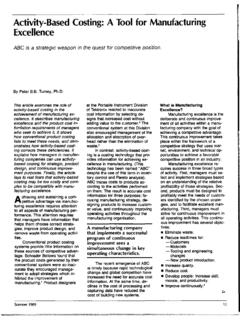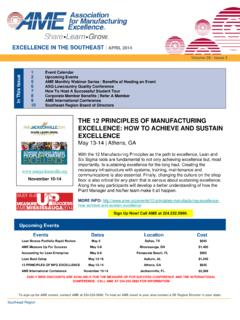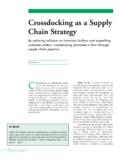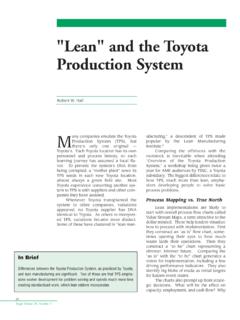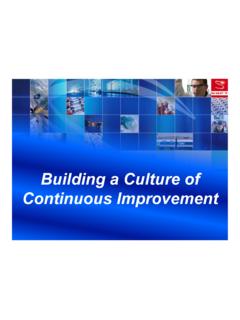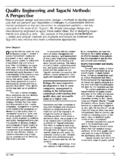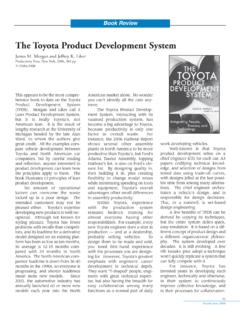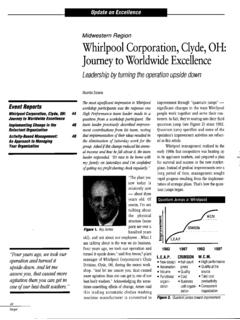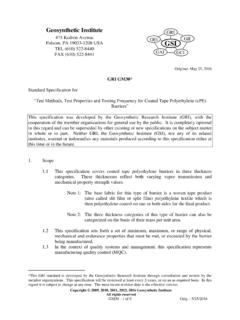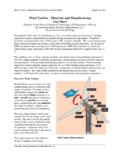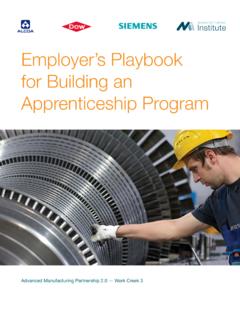Transcription of Challenges Facing the Manufacturing Industry and …
1 Page1 Challenges Facing the Manufacturing Industry and Taking the First Steps toward the Revitalization of Manufacturing President Barack Obama has a plan to revive Manufacturing , the anchor of the economic blueprint he sketched out during his State of the Union address in January 2012. The President promised to breathe new life into this sector of the economy, which has been declining for decades. Unfortunately, nearly six million Manufacturing jobs were lost in the United States from January 2000 to December 2009, for an average of approximately 54,000 per month. From January 2010 through January 2011, the added a total of 152,000 Manufacturing jobs at an average rate of 11,800 per month, according to the Department of Commerce and Department of Labor. Manufacturing is very critical to economic growth, prosperity and a higher standard of living.
2 Part of the reason for that is its multiplier effect. More than any other sector in the economy, Manufacturing creates the most wealth. Manufacturing pays higher wages and provides greater benefits, on average, than other industries. It performs almost two-thirds of private sector research and development, creates the highest number of jobs to support the Industry while serving the surrounding communities, and contributes to more than 50 percent of the country s total exports. Manufacturers and policy-makers are realizing how dependent Canada, Mexico and the United States are on each other. The top two North American markets for exports are Canada and Mexico, making Made in North America a priority. The Challenges America has a huge problem. It faces four major Challenges on which its future depends and has been failing to meet them.
3 In That Used to Be Us, How America Fell Behind in the World It Invented and How We Can Come Back by Thomas L. Friedman and Michael Mandelbaum, the authors analyze those Challenges globalization, the revolution in information technology, the nation s chronic deficits and its pattern of energy consumption. In addition, the authors point out how America's educational system has not adapted to changed priorities around the world the critical need for more math, physics, engineering and technical knowledge and skills in economic development. This has caused Americans to rapidly lose jobs, while more emphasis on these subjects in China, India and other countries has made America's competitors gain employment in Manufacturing . The National Association of Manufacturers (NAM) Manufacturing Institute 2011 Skills Gap study states that 82 percent of manufacturers have a moderate or serious shortage of skilled production workers, and 5 percent of all Manufacturing jobs or 600,000 jobs are open because there is no qualified talent.
4 In addition, million Manufacturing employees are 55 years of age or older and likely to leave the labor force over the next 10 years. The growing shortage of skilled workers needed for North American manufacturers to sustain and grow the business are compounded by a 20 percent structural cost burden compared to our key trading partners as reflected in the Structural Cost of Manufacturing study. Page2 To participate fully in society and the workplace, citizens will need powerful literacy abilities that until now have been achieved by only a small percentage of the population. Having a steady supply of highly skilled workers, scientists, researchers and engineers is seen as the top driver of the Manufacturing competitiveness of nations and the standard of living of their people. Students in the United States are trailing other industrialized nations as reported in the 2009 report of the Program for International Student Assessment.
5 These results show America as being average in reading and science, and below average in math. America s high school graduation rate ranks 19th in the world, while 40 years ago, we were number one. Other factors contributed to the current situation and future of Manufacturing jobs, and much can be attributed to laws and regulations that make it more difficult for manufacturers to meet foreign competition on level ground. Every new expense, whether it is to comply with new regulations, to fund government programs or to defend lawsuits and pay unwarranted claims, is a loss to the high-quality, job-generating capacity of Manufacturing . Breathing New Life into Manufacturing The public and private sectors must come together to build on the NAM study, A Manufacturing Renaissance: Four Goals for Economic Growth, to revitalize the Industry and grow the economy.
6 The strategy calls for putting people, schools, businesses and the government to work; producing literate career-ready citizens capable of joining the workforce; and enabling manufacturers to once again lead the designing, building and exporting of quality products and services around the globe. The top three priorities for revitalizing Manufacturing proposed by National Council For Advanced Manufacturing and its alliance partners are: Build a better educated and trained workforce Promote product and process innovation, as well as research and development Improve global competitiveness for companies Each priority contains elements that must be considered in developing public policies that support the revitalization of the Manufacturing sector, and policy-makers must consider these elements in shaping future public policy and legislation.
7 Their goal should be to help public school systems and companies transform themselves to compete in more knowledge-intensive and information-fueled innovative processes, leading to more competitiveness by putting people back to work building things at home. President Obama praised companies that are bringing Manufacturing jobs back to the United States from abroad at a White House conference where he met with leaders of firms investing in South Carolina and other states. I don t want the next generation of Manufacturing jobs taking root in countries like China or Germany, President Obama said. I want them taking root in places like Michigan and Ohio and Virginia and North Carolina. The Association for Manufacturing Excellence (AME) has been leading the Revitalization of Manufacturing initiative, where AME, along with other organizations, has been reaching out to policy-makers nationwide, and encouraging them to join or develop efforts focusing on local and state job creation.
8 It is imperative that policy-makers recognize the importance of an Industry that has been the backbone of the North American economy. To date, AME has received more than 400 signatures of support from state and federal policy-makers, Industry trade associations and operations executives representing manufacturers across North America. Virginia was the first state to pledge its support for AME s initiative, and is also the top state named in CNBC s Special Report: America s Top States for Business 2011. The Commonwealth and its businesses have been actively engaged in promoting Manufacturing excellence. Page3 For example, the Virginia Economic Development Partnership conducts advanced Manufacturing tours to showcase how the Commonwealth s business climate facilitates the Industry s success.
9 Highlights of the tour this year include Newport News Shipbuilding (NNS) and Germane Systems, both of which are active participants in supporting AME initiatives by opening their doors to share best practices during plant tours. These companies also strive to individually foster a robust Manufacturing environment within Virginia. Germane Systems, for instance, was selected as a tour site for AME s Annual International Conference in 2010. The company has been such an advocate for Manufacturing excellence that the Virginia Deputy Secretary of Commerce and Trade, Carrie Cantrell, presented a letter from Governor Robert McDonnell that praised the company for its support of the revitalization of Manufacturing within the state. Over the years, NNS has benefited from its relationship with AME by sharing and adopting Industry best practices, which accelerate its journey to achieve operational excellence.
10 Even as the Navy, one of NNS biggest customers, contemplates possible cuts to ship orders, NNS continues to move full-speed ahead with plans to hire thousands of workers in the next five years. By maintaining a highly skilled workforce and utilizing best practices, NNS can grow its business. The Commonwealth recognizes that Manufacturing drives technology, productivity and innovation across all Industry sectors, and Governor McDonnell endorses the Revitalization of Manufacturing initiative, through which the collaborative sharing of best practices to make organizations more competitive will lead to the creation of countless new jobs. AME is joining with its corporate members and other leading learning organizations to adopt these top three priorities for revitalizing Manufacturing by engaging in reforming public education to produce career-ready citizens; establishing consortiums to help sustain and grow businesses through sharing technology and innovative ideas; reshoring (insourcing); and redeploying Training Within Industry (TWI) programs to train or retrain workers who have the ability to work in advanced Manufacturing jobs, which will ultimately revitalize Manufacturing and re-energize the economy.
